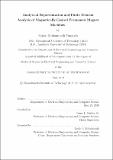| dc.contributor.advisor | James L. Kirtley Jr. | en_US |
| dc.contributor.author | Mohammadi Yangijeh, Sajjad. | en_US |
| dc.contributor.other | Massachusetts Institute of Technology. Department of Electrical Engineering and Computer Science. | en_US |
| dc.date.accessioned | 2019-11-04T19:54:05Z | |
| dc.date.available | 2019-11-04T19:54:05Z | |
| dc.date.copyright | 2019 | en_US |
| dc.date.issued | 2019 | en_US |
| dc.identifier.uri | https://hdl.handle.net/1721.1/122702 | |
| dc.description | This electronic version was submitted by the student author. The certified thesis is available in the Institute Archives and Special Collections. | en_US |
| dc.description | Thesis: S.M., Massachusetts Institute of Technology, Department of Electrical Engineering and Computer Science, 2019 | en_US |
| dc.description | Cataloged from student-submitted PDF version of thesis. | en_US |
| dc.description | Includes bibliographical references (pages 205-209). | en_US |
| dc.description.abstract | Recently, magnetic gears have drawn significant interest as a promising alternative to their mechanical counterparts by introducing features such as generating high torque at low speed, reduced acoustic noise and vibrations, low maintenance, inherent overload protection, improved reliability, physical isolation between shafts, and contactless power transfer. Conventional electrical machines can be combined with magnetic gears to form a compact device called a magnetically-geared machine. They have found their way into mechatronics, wind turbines, wave energy generation and electric vehicles. Such devices can be studied by numerical techniques or analytical frameworks. The former such as finite element methods (FEM), although powerful, is expensive and time-consuming, while the latter approach like flux-tube based models provide a flexible yet reasonable solution for preliminary designs and optimizations. | en_US |
| dc.description.abstract | In this thesis, there has been a comprehensive study on flux-tube based modeling and finite element analysis of the machine. The stator is represented using flux-tube based carterâĂŹs coefficient and a surface current density. The permanent magnets are modeled by different approaches including magnetization density, Coulombian fictitious charges and Amperian currents. The air-gap permeances are also modeled by flux-tubes. Closed-form expressions for the magnetic fields has been extracted. The developed torques has been calculated by different techniques including Maxwell stress tensor, Lorentz force and Kelvin force density. These options provide designers with a universal and flexible framework, enabling them to pick the best technique according to the configuration and application. The field modulation concepts and the gearing effects have been investigated using the developed analytical framework as well as 2D and 3D FEM, whose results agree. | en_US |
| dc.description.abstract | Both radial-flux and axial-flux configurations, the two main structures of rotating electrical machines, have been studied as well. | en_US |
| dc.description.statementofresponsibility | by Sajjad Mohammadi Yangijeh. | en_US |
| dc.format.extent | 209 pages | en_US |
| dc.language.iso | eng | en_US |
| dc.publisher | Massachusetts Institute of Technology | en_US |
| dc.rights | MIT theses are protected by copyright. They may be viewed, downloaded, or printed from this source but further reproduction or distribution in any format is prohibited without written permission. | en_US |
| dc.rights.uri | http://dspace.mit.edu/handle/1721.1/7582 | en_US |
| dc.subject | Electrical Engineering and Computer Science. | en_US |
| dc.title | Analytical representation and finite element analysis of magnetically-geared permanent magnet machines | en_US |
| dc.type | Thesis | en_US |
| dc.description.degree | S.M. | en_US |
| dc.contributor.department | Massachusetts Institute of Technology. Department of Electrical Engineering and Computer Science | en_US |
| dc.identifier.oclc | 1124925818 | en_US |
| dc.description.collection | S.M. Massachusetts Institute of Technology, Department of Electrical Engineering and Computer Science | en_US |
| dspace.imported | 2019-11-04T19:54:04Z | en_US |
| mit.thesis.degree | Master | en_US |
| mit.thesis.department | EECS | en_US |
